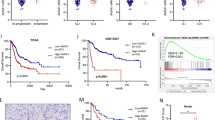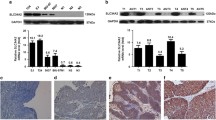Abstract
Drug resistance and recurrence are the major obstacles to bladder cancer chemotherapy. Our laboratory had reported that nucleophosmin1 was one of the differentially expressed proteins between bladder cancer cell lines PUMC-91 and PUMC-91/1.0ADM based on 2D-PAGE proteomics approaches. In this study, we want to explore the relationship among nucleophosmin1, drug resistance, and recurrence of bladder cancer, using normal bladder epithelia cell line SV-HUC-1, bladder cancer cell lines PUMC-91, PUMC-91 against gradient doses of adriamycin (0.3, 0.6, and 1.0 μg/ml), and bladder cancer tissue samples. The bladder cancer tissue samples were divided into two groups according to the interval of recurrence (<6 months and >2 years). The differences were detected by Western blotting and immunohistochemistry. The protein of nucleophosmin1 was differentially expressed with each other in SV-HUC-1, PUMC-91, PUMC-91/0.3ADM, and PUMC-91/1.0ADM (p < 0.05). Nucleophosmin1 was less expressed in later recurring (>2 years) bladder cancer tissue samples compared with samples that recurred <6 months (p = 0.035). The expression of nucleophosmin1 was independently associated with gradient drug resistance and recurrent frequency of bladder cancer. Nucleophosmin1 was a key regulator in either a drug-resistant bladder cancer or bladder cancer recurrence model. It may be possible to think nucleophosmin1 can provide more helpful information for clinical drug treatment of bladder cancer patients and frequently recurred ones.








Similar content being viewed by others
References
Tsui KH, Cheng AJ, Chang Pe, Pan TL, Yung BY (2004) Association of nucleophosmin/B23 mRNA expression within clinical outcome in patients with bladder carcinoma. Urology 64:839–844
Raghaven D, Shipley WU, Garnick MB, Russell PJ, Richie JP (1990) Biology and management of bladder cancer. N Engl J Med 322:1129–1138
Newling DW (1996) Preventing recurrence and progression in superficial bladder cancer. Curr Opin Urol 6:272–279
Gecka T, Junker K, Franz M, Richter P, Walther M, Voigt A, Neri D, Kosmehl H, Wunderlich H, Kiehntopf M, Berndt A (2011) B domain containing Tenascin-C: a newmarker for surveillance of patients with urothelial carcinoma of the urinary bladder? Clin Chim Acta 412:1931–1936
Sullivan PS, Chan JB, Levin MR, Rao J (2010) Urine cytology and adjunct markers for detection and surveillance of bladder cancer. Am J Transl Res 2:412–420
Keesee SK, Briggman JV, Thill G, Wu YJ (1996) Utilization of nuclear matrix proteins for cancer diagnosis. Crit Rev Eukaryot Gene Expr 6:189–214
Tsihlias J, Grossman HB (2000) The utility of fibrin/fibrinogen degradation products in superficial bladder cancer. Urol Clin North Am 27:39–46
Ramakumar S, Bhuiyan J, Besse JA, Roberts SG, Wollan PC, Blute ML, O’Kane DJ (1996) Comparison of screening methods in the detection of bladder cancer. J Urol 161:388–394
Lei T, Zhao X, Jin S, Meng Q, Zhou H, Zhang M (2013) Discovery of potential bladder cancer biomarkers by comparative urine proteomics and analysis. Clin Genitourin cancer 11:56–62
Frehlick LJ, Eirin-Lopez JM, Ausio J (2007) New insights into the Nucleophosmin/nucleoplasmin family of nuclear chaperones. BioEssay 29:49–59
Yung BY (2007) Oncogenic role of Nucleophosmin/B23. Chang Gung Med J 30:285–293
Bergstralh DT, Conti BJ, Moore CB, Bricker WJ, Taxman DJ, Ting P-YJ (2006) Global functional analysis of nucleophosmin in Taxol response, cancer, chromatin regulation, and ribosomal DNA transcription. Exp Cell Res 313:65–76
Lin CY, Liang YC, Yung BY (2006) Nucleophosmin/B23 regulates transcriptional activation of E2F1 via modulating the promoter binding of NF-kB, E2F1 and pRB. Cell Signal 18:2041–2048
Di Fiore PP (2008) Playing both sides: nucleophosmin between tumor suppression and oncogenesis. J. Cell Bio 182:7–9
Sanjit KD, Daret KC (2009) Nucleophosmin blocks mitochondrial localization of p53 and apoptosis. J Biol Chem 284:16409–16418
Qi W, Shakalya K, Stejskal A, Goldman A, Beeck S, Cooke L, Mahadevan D (2008) NSC348884, a nucleophosmin inhibitor disrupts oligomer formation and induces apoptosis in human cancer cells. Oncogene 27:4210–4220
Tsui KH, Juang HH, Lee TH, Chang PL, Chen CL, Yung BY (2008) Association of nucleophosmin/B23 with bladder cancer recurrence based on immunohistochemical assessment in clinical samples. Acta Pharmacol Sin 29:364–370
Hendricks JB, Wilkinson EJ (1994) Quality control consideration for ki-67 detection and quantitation in paraffin-embedded tissue. J Cell Biochem Suppl 19:105–110
Tada Y, Wada M, Taguchi K, Mochida Y, Kinugawa N, Tsuneyoshi M (2002) The association of death-associated protein kinase hypermethylation with early recurrence in superficial bladder cancers. Cancer Res 62:4048–4053
Zhang JT, Liu Y (2007) Use of comparative proteomics to identify potential resistance mechanisms in cancer treatment. Cancer Treat Rev 33:741–756
de Jonge-Peeters SD, Kuipers F, de Vries EG, Vellenga E (2007) ABC transporter expression in hematopoietic stem cells and the role in AML drug resistance. Crit Rev Oncol Hematol 62:214–226
Liu Y, Liu H, Han B, Zhang JT (2006) Identification of 14-3-3 s as a contributor to drug resistance analysis in human breast cancer cells using functional proteomic. Cancer Res 66:3248–3255
Kim CK, Nguygen TL, Lee SB, Park SB, Lee KH, Cho SW, Ahn JY (2011) Akt2 and nucleophosmin/B23 function as an oncogenic unit in human lung cancer cells. Exp Cell Res 317:966–975
Meng Q, Lei T, Zhang M, Zhao J, Zhao XH, Zhang M (2013) Identification of proteins differentially expressed in adriamycin-resistant (pumc-91/ADM) and parental (pumc-91) human bladder cancer cell lines by proteome analysis. J Cancer Res Clin 139:509–519
Hu J, Lin M, Liu T, Li J, Chen B, Chen Y (2011) DIGE-based proteomic analysis identifies nucleophosmin/B23 and nucleolin C23 as over-expressed proteins in relapsed/refractory acute leukemia. Leuk Res 35:1087–1092
Acknowledgments
The authors would like to thank all the staffs in clinical laboratory of Beijing Shijitan Hospital for enthusiastic assistance. The authors report no conflict of interest. The authors alone are responsible for the content of this article. The project has received funding from Beijing Natural Science Foundation Research on the Urinary biomarker of bladder cancer 7122086.
Conflict of interest
The authors report no conflict of interest.
Author information
Authors and Affiliations
Corresponding author
Rights and permissions
About this article
Cite this article
Hu, H., Meng, Q., Lei, T. et al. Nucleophosmin1 associated with drug resistance and recurrence of bladder cancer. Clin Exp Med 15, 361–369 (2015). https://doi.org/10.1007/s10238-014-0288-3
Received:
Accepted:
Published:
Issue Date:
DOI: https://doi.org/10.1007/s10238-014-0288-3




